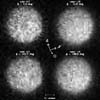| . |  |
. |
There are asteroids and there are asteroids. Most were once part of larger "parent bodies" and some supply meteorites that plunge to Earth. But how do you trace the family line of asteroids? Scientists compare mineralogy of asteroids by analyzing their near-infrared spectra. They also compare asteroids' orbits around the sun. And recently they found a perfect match -- "uniting" in a scientific sense, mother and daughter asteroids. "We determined the mineralogy of asteroid 1929 Kollaa and found that it was once part of a larger asteroid called 4 Vesta. I was inspired to observe these objects because they belong to the rare V-class of asteroids, and they have orbits about the Sun that are very similar," explained Michael Kelley from NASA's Johnson Space Center. "Vesta is the asteroid for which the V-class was established. Until now, no mineralogical analysis had ever been done on another V-type. In that sense, Vesta was unique until our recent work was done. We found not only that this second V-class asteroid, 1929 Kollaa, was once part of Vesta, but that it is also related to a very specific group of meteorites." Kelley presented this new discovery November 8, at the Geological Society of America's annual meeting in Boston. Most planetary scientists believe that 4 Vesta is the source of howardite, eucrite, and diogenite meteorites (HED) found on Earth, but Kelley points out that it is not a direct process. "Vesta is located in a part of the main asteroid belt that makes it almost impossible for it to deliver meteorites directly to Earth. So there are probably intermediate asteroids, which were once part of Vesta, located in more favorable orbits that provide delivery." One of the ramifications of this discovery is that it will help scientists build a geologic map of the asteroid belt and understand what forces have acted on asteroids in the past. This information, along with asteroids' mineralogy, would be crucial if there was ever a need to prevent an asteroid from striking the Earth and causing a major disaster. Related Links Geological Society of America SpaceDaily Search SpaceDaily Subscribe To SpaceDaily Express  Boulder - Nov 2, 2001
Boulder - Nov 2, 2001An international team led by scientists at the Southwest Research Institute (SwRI) has discovered some curious properties of the largest asteroid, Ceres.
|
| ||||||||||
| The content herein, unless otherwise known to be public domain, are Copyright 1995-2016 - Space Media Network. All websites are published in Australia and are solely subject to Australian law and governed by Fair Use principals for news reporting and research purposes. AFP, UPI and IANS news wire stories are copyright Agence France-Presse, United Press International and Indo-Asia News Service. ESA news reports are copyright European Space Agency. All NASA sourced material is public domain. Additional copyrights may apply in whole or part to other bona fide parties. Advertising does not imply endorsement, agreement or approval of any opinions, statements or information provided by Space Media Network on any Web page published or hosted by Space Media Network. Privacy Statement All images and articles appearing on Space Media Network have been edited or digitally altered in some way. Any requests to remove copyright material will be acted upon in a timely and appropriate manner. Any attempt to extort money from Space Media Network will be ignored and reported to Australian Law Enforcement Agencies as a potential case of financial fraud involving the use of a telephonic carriage device or postal service. |